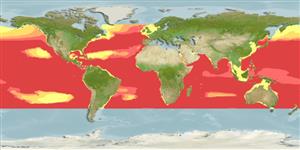Environment: milieu / climate zone / Tiefenbereich / distribution range
Ökologie
seewasser bathypelagisch; tiefenbereich 16 - 4663 m (Ref. 58302), usually 600 - 1800 m (Ref. 58302). Deep-water; 61°N - 40°S, 180°W - 180°E
Atlantic, Indian and Pacific: in tropical to temperate waters. Southern Ocean: Indian Ocean sector south of Australia. South China Sea (Ref.74511).
Length at first maturity / Size / Gewicht / Alter
Geschlechtsreife: Lm 4.3 range ? - ? cm
Max length : 4.8 cm SL Männchen/unbestimmt; (Ref. 5162); 7.5 cm SL (female)
Rückenflossenstacheln (insgesamt) : 0; Rückenflossenweichstrahlen (insgesamt) : 12 - 15; Afterflossenstacheln: 0; Afterflossenweichstrahlen: 16 - 19. Light to dark brown in color; transparent or slightly pigmented immediately anterior to anal and dorsal origin; median fin rays and internasal area pigmented; meningeal pigment extending to level of rear margin of eye (Ref. 3991).
Body shape (shape guide): elongated.
Meso- to bathypelagic (Ref. 58302). Oceanic, precise depth range dependent upon developmental stage, latitude, season (Ref. 4769). Does not exhibit diel vertical migrations (Ref. 4769). Lipid content is 2.3 % in fresh body weight and wax ester is 34.0 % in total lipids (Ref. 9193).
Gon, O., 1990. Gonostomatidae. p. 116-122. In O. Gon and P.C. Heemstra (eds.) Fishes of the Southern Ocean. J.L.B. Smith Institute of Ichthyology, Grahamstown, South Africa. 462 p. (Ref. 5162)
IUCN Rote Liste Status (Ref. 130435: Version 2025-1)
Bedrohung für Menschen
Harmless
Nutzung durch Menschen
Fischereien: nicht kommerziell
Tools
Zusatzinformationen
Download XML
Internet Quellen
Estimates based on models
Preferred temperature (Ref.
123201): 2.5 - 8.7, mean 4.2 °C (based on 3651 cells).
Phylogenetic diversity index (Ref.
82804): PD
50 = 0.5001 [Uniqueness, from 0.5 = low to 2.0 = high].
Bayesian length-weight: a=0.00389 (0.00172 - 0.00881), b=2.99 (2.79 - 3.19), in cm total length, based on LWR estimates for this (Sub)family-body shape (Ref.
93245).
Trophic level (Ref.
69278): 3.2 ±0.36 se; based on food items.
Widerstandsfähigkeit (Ref.
120179): mittel, Verdopplung der Population dauert 1,4 - 4,4 Jahre. (tm=3.5).
Fishing Vulnerability (Ref.
59153): Low vulnerability (10 of 100).
🛈
